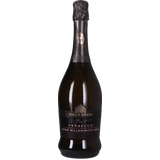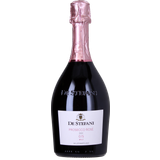A World First: Prosecco DOC Rosé
All about the taste & production of this pink treat
All facts about Prosecco DOC Rosé at a glance:
- Glera grapes are used for Prosecco
- Since 2021 there has been a rosé version
- For this purpose, 10-15% Pinot Noir is added to the Glera grapes
- Strict rules apply to the production of Prosecco DOC Rosé
- Taste: Refreshingly fruity with aromas of strawberries, raspberries and a hint of roses
- Particularly fine perlage is typical
Rosy prospects
Prosecco DOC (Denominazione di Origine Controllata) is an export hit, known all over the world and representing the Italian attitude to life. Around 500 million bottles of this Italian sparkling wine are produced each year in the vineyards of Veneto and Friuli-Venezia Giulia. Incidentally, until the end of 2009, Prosecco was also the name of the white grape variety used for Prosecco. Consequently, sparkling wines that were not produced in the DOC growing areas could also be sold as Prosecco. To avoid this, the grape variety was renamed Glera. This only grows in the north-east of Italy and is considered a sign of quality and a designation of origin.
In 2009, the designations of origin DOC and DOCG were replaced by the DOP seal (Denominazione di origine protetta). Nevertheless, the previous quality levels (DOC and DOCG) are permitted and may still be used for reasons of inventory protection.
Until now, Prosecco had to contain at least 85% of the Glera and was only available in the white version. In 2019, after revising the production regulations, the DOC Prosecco committee decided that from 2021 (starting with the 2020 harvest) a rosé version would also be permitted. For this purpose, about 10-15 percent Pinot Noir is added to the Glera grape to create a pink colour, structure and fine berry aromas. Although pink sparkling wine has been produced in northern Italy for a long time, it was previously not allowed to be called Prosecco.
Strict rules
Just like the white version of Prosecco, rosé Prosecco may only be produced in precisely defined provinces in northern Italy. Prosecco (including osé) is only recognised as a DOC if all steps, from harvesting to bottling, take place in the Veneto and Friuli-Venezia Giulia regions. In contrast to white Prosecco, cheaper frizzante (sparkling wines) are not permitted to have a rosé version. According to the regulations, rosé Prosecco must be produced without exception using the more complex Spumante process. This requires a second fermentation on the yeast. Incidentally, the rosé version must mature on the yeast for at least 60 days. In addition to 85 percent Glera (minimum), a Prosecco Rosé must contain at least 10 percent Pinot Noir. The vintage should be specified on the front and back, and preceded by the term Millesimato. This is confirmation that at least 85 percent of the grapes come from the specified year.
Elaborate production
As already mentioned, the Spumante process is used for a Rosé Prosecco. With a spumante, the carbonic acid is created naturally through a second fermentation process. However, this does not take place in the bottle as with champagne, but with the help of the Metodo Martinotti (Italian) or the Méthode Charmant (tank fermentation). The fermentation process takes place in large pressure tanks, in which the sparkling wine remains for at least 60 days. This ensures the delicately sparkling, creamy perlage.
What rosé prosecco tastes like
Like the white version, rosé Prosecco is available, for example, as Brut Nature (less than 3 g/l residual sugar), Extra Brut (0-6 g/l residual sugar), Brut (up to 12 g/l residual sugar) and Extra Dry (12-17 g/l residual sugar). Brut Nature means very dry and Extra Dry means dry to medium dry. When you smell the glass for the first time, aromas of strawberries, raspberries and a hint of roses are immediately detectable. On the palate, the rosé version is wonderfully fruity, fresh, lively and, above all, juicy. Similar to the white Prosecco only with an extra portion of fruit, which is wonderfully carried by fine bubbles. Curious? Then you should definitely try Villa Sandi's rosé Prosecco!
Rosé Prosecco DOC Millesimato 2019 by Villa Sandi
This world first from the famous Prosecco producer Villa Sandi is a vintage Prosecco in an exclusive bottle. Vivid pink shimmers through delicate pearls. Fruity aromas of light berries with some roses. Elegant and stimulating on the nose and palate. The delicate sweetness (brut - around 12g residual sugar) suits this sparkling wine very well. A refreshing experience that guarantees fun!
Ideal as an aperitif, for any celebration or even to accompany seafood or cheese.
Related products
-
 5.0 (5)
5.0 (5)Villa Sandi Prosecco Rosé Prosecco DOC Millesimato 2023, 0,75 L
- Made from Glera and Pinot Noir grapes
- Light, delicately sparkling, grapey
- A great aperitif for any celebration
CHF 12.00 (CHF 16.00 / L)Delivery by April 28
-
-
 4.7 (13)
4.7 (13)De Stefani Prosecco Rosé 0.15 Millesimato Brut DOC 2023, 0,75 L
- A lot of fruit thanks to the special fermentation method
- Fine perlage, slightly creamy on the palate
- Great summer drink, also a pleasure on ice
CHF 13.50 (CHF 18.00 / L)Delivery by April 28
-
Magazine Articles:
Discover 9wines CH:
-
Switzerland: Free standard delivery from CHF 80.00
-
We operate in a
climate-conscious manner. Secure payments
with SSL encryption technology






